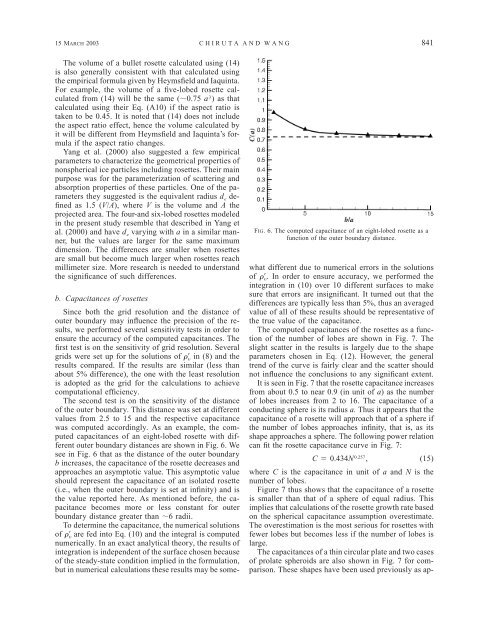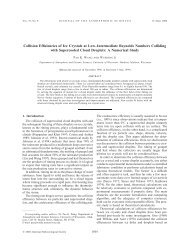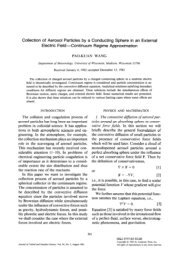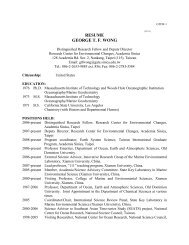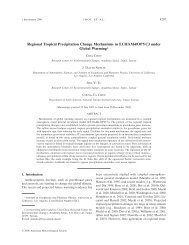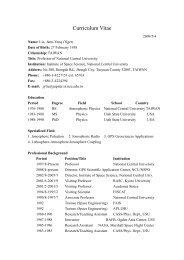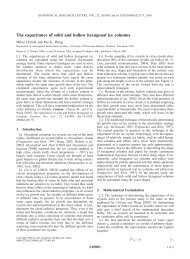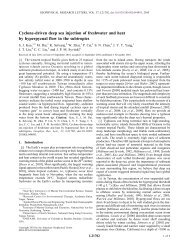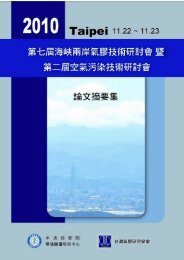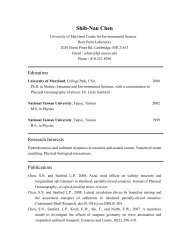The Capacitance of Rosette Ice Crystals - University of Wisconsin ...
The Capacitance of Rosette Ice Crystals - University of Wisconsin ...
The Capacitance of Rosette Ice Crystals - University of Wisconsin ...
You also want an ePaper? Increase the reach of your titles
YUMPU automatically turns print PDFs into web optimized ePapers that Google loves.
15 MARCH 2003 CHIRUTA AND WANG<br />
841<br />
<strong>The</strong> volume <strong>of</strong> a bullet rosette calculated using (14)<br />
is also generally consistent with that calculated using<br />
the empirical formula given by Heymsfield and Iaquinta.<br />
For example, the volume <strong>of</strong> a five-lobed rosette calculated<br />
from (14) will be the same (0.75 a 3 ) as that<br />
calculated using their Eq. (A10) if the aspect ratio is<br />
taken to be 0.45. It is noted that (14) does not include<br />
the aspect ratio effect, hence the volume calculated by<br />
it will be different from Heymsfield and Iaquinta’s formula<br />
if the aspect ratio changes.<br />
Yang et al. (2000) also suggested a few empirical<br />
parameters to characterize the geometrical properties <strong>of</strong><br />
nonspherical ice particles including rosettes. <strong>The</strong>ir main<br />
purpose was for the parameterization <strong>of</strong> scattering and<br />
absorption properties <strong>of</strong> these particles. One <strong>of</strong> the parameters<br />
they suggested is the equivalent radius d e defined<br />
as 1.5 (V/A), where V is the volume and A the<br />
projected area. <strong>The</strong> four-and six-lobed rosettes modeled<br />
in the present study resemble that described in Yang et<br />
al. (2000) and have d e varying with a in a similar manner,<br />
but the values are larger for the same maximum<br />
dimension. <strong>The</strong> differences are smaller when rosettes<br />
are small but become much larger when rosettes reach<br />
millimeter size. More research is needed to understand<br />
the significance <strong>of</strong> such differences.<br />
FIG. 6. <strong>The</strong> computed capacitance <strong>of</strong> an eight-lobed rosette as a<br />
function <strong>of</strong> the outer boundary distance.<br />
b. <strong>Capacitance</strong>s <strong>of</strong> rosettes<br />
Since both the grid resolution and the distance <strong>of</strong><br />
outer boundary may influence the precision <strong>of</strong> the results,<br />
we performed several sensitivity tests in order to<br />
ensure the accuracy <strong>of</strong> the computed capacitances. <strong>The</strong><br />
first test is on the sensitivity <strong>of</strong> grid resolution. Several<br />
grids were set up for the solutions <strong>of</strong> in (8) and the<br />
results compared. If the results are similar (less than<br />
about 5% difference), the one with the least resolution<br />
is adopted as the grid for the calculations to achieve<br />
computational efficiency.<br />
<strong>The</strong> second test is on the sensitivity <strong>of</strong> the distance<br />
<strong>of</strong> the outer boundary. This distance was set at different<br />
values from 2.5 to 15 and the respective capacitance<br />
was computed accordingly. As an example, the computed<br />
capacitances <strong>of</strong> an eight-lobed rosette with different<br />
outer boundary distances are shown in Fig. 6. We<br />
see in Fig. 6 that as the distance <strong>of</strong> the outer boundary<br />
b increases, the capacitance <strong>of</strong> the rosette decreases and<br />
approaches an asymptotic value. This asymptotic value<br />
should represent the capacitance <strong>of</strong> an isolated rosette<br />
(i.e., when the outer boundary is set at infinity) and is<br />
the value reported here. As mentioned before, the capacitance<br />
becomes more or less constant for outer<br />
boundary distance greater than 6 radii.<br />
To determine the capacitance, the numerical solutions<br />
<strong>of</strong> are fed into Eq. (10) and the integral is computed<br />
numerically. In an exact analytical theory, the results <strong>of</strong><br />
integration is independent <strong>of</strong> the surface chosen because<br />
<strong>of</strong> the steady-state condition implied in the formulation,<br />
but in numerical calculations these results may be somewhat<br />
different due to numerical errors in the solutions<br />
<strong>of</strong> . In order to ensure accuracy, we performed the<br />
integration in (10) over 10 different surfaces to make<br />
sure that errors are insignificant. It turned out that the<br />
differences are typically less than 5%, thus an averaged<br />
value <strong>of</strong> all <strong>of</strong> these results should be representative <strong>of</strong><br />
the true value <strong>of</strong> the capacitance.<br />
<strong>The</strong> computed capacitances <strong>of</strong> the rosettes as a function<br />
<strong>of</strong> the number <strong>of</strong> lobes are shown in Fig. 7. <strong>The</strong><br />
slight scatter in the results is largely due to the shape<br />
parameters chosen in Eq. (12). However, the general<br />
trend <strong>of</strong> the curve is fairly clear and the scatter should<br />
not influence the conclusions to any significant extent.<br />
It is seen in Fig. 7 that the rosette capacitance increases<br />
from about 0.5 to near 0.9 (in unit <strong>of</strong> a) as the number<br />
<strong>of</strong> lobes increases from 2 to 16. <strong>The</strong> capacitance <strong>of</strong> a<br />
conducting sphere is its radius a. Thus it appears that the<br />
capacitance <strong>of</strong> a rosette will approach that <strong>of</strong> a sphere if<br />
the number <strong>of</strong> lobes approaches infinity, that is, as its<br />
shape approaches a sphere. <strong>The</strong> following power relation<br />
can fit the rosette capacitance curve in Fig. 7:<br />
0.257<br />
C 0.434N , (15)<br />
where C is the capacitance in unit <strong>of</strong> a and N is the<br />
number <strong>of</strong> lobes.<br />
Figure 7 thus shows that the capacitance <strong>of</strong> a rosette<br />
is smaller than that <strong>of</strong> a sphere <strong>of</strong> equal radius. This<br />
implies that calculations <strong>of</strong> the rosette growth rate based<br />
on the spherical capacitance assumption overestimate.<br />
<strong>The</strong> overestimation is the most serious for rosettes with<br />
fewer lobes but becomes less if the number <strong>of</strong> lobes is<br />
large.<br />
<strong>The</strong> capacitances <strong>of</strong> a thin circular plate and two cases<br />
<strong>of</strong> prolate spheroids are also shown in Fig. 7 for comparison.<br />
<strong>The</strong>se shapes have been used previously as ap-


